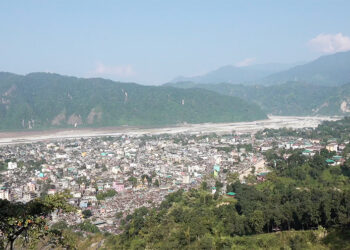 The Punatsangchhu-II Hydroelectric Project generated nearly 27 M units of electricity since the commissioning of two of its six units on the 17th of last month until Sunday. This is equivalent to 27 megawatts which is being consumed within the country to meet domestic demand. The PHPA-II authority has sold the electricity to Bhutan Power Corporation. Once fully operational, PHPA-II is expected to start exporting power to India and generate an annual revenue of Nu 20bn.
The Punatsangchhu-II Hydroelectric Project generated nearly 27 M units of electricity since the commissioning of two of its six units on the 17th of last month until Sunday. This is equivalent to 27 megawatts which is being consumed within the country to meet domestic demand. The PHPA-II authority has sold the electricity to Bhutan Power Corporation. Once fully operational, PHPA-II is expected to start exporting power to India and generate an annual revenue of Nu 20bn.
The Department of Energy says it cannot disclose revenue generated from sales to BPC until the Royal Government and the Government of India finalise the tariff.
However, the rate is expected to be higher than that of Mangdechhu. Following the latest revision, the Mangdechhu hydropower project is currently exporting electricity to India at Nu 4.53 per unit.
“The Bhutanese and Indian governments are currently negotiating the tariff. Once finalized, a Power Purchasing Agreement (PPA) will need to be signed to enable power exports. Until then, the revenue generated from sales to BPC cannot be disclosed,” said Karma P Dorji, the Director General of the Department of Energy.
He added that the commissioning of PHPA-II has reduced Bhutan’s electricity import during the lean season.
While Bhutan imports 300 to 700 MW of power daily, PHPA-II currently generates only 170 MW daily as only one unit is operational due to the limited flow of water during winter.
With domestic demand reaching 1,026 MW and the power generation capacity of the existing plants dropping close to 435 MW during the lean season, Bhutan relies on imports to meet the shortfall.
Meanwhile, the Department of Energy says the issue of water seepage in the powerhouse of PHPA-II is being resolved.
The Director General said, “Water seepage is inevitable in all powerhouses, including Punatsangchhu-II, due to the large-scale water tunnels and significant water flow involved. While it is not a major concern at present, any significant seepage issues in the future may require shutting down the powerhouse, draining the water, and carrying out necessary maintenance.”
He added that PHPA-II plays a key role in Bhutan’s vision to become a regional energy hub by increasing power export capacity, enhancing energy security, promoting sustainable energy, and strengthening regional partnerships.
Works to commission the remaining four units have commenced and are expected to be ready on or before the monsoon.
The 1,020 MegaWatt Punatsangchhu-II Project is being implemented jointly by the Royal Government and the Government of India.
Tashi Dekar
Edited by Phub Gyem









